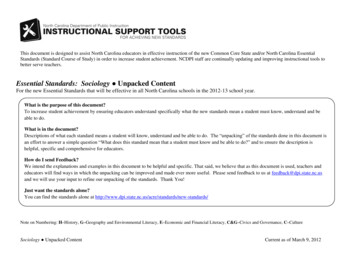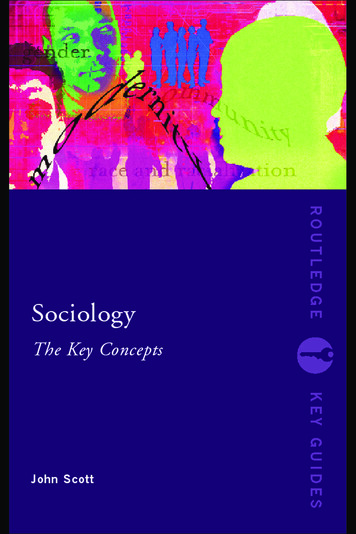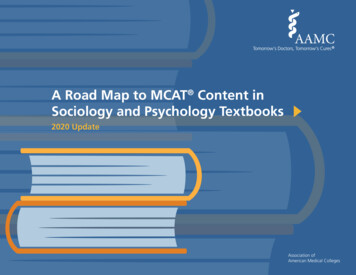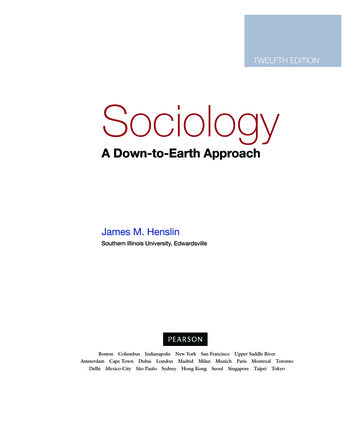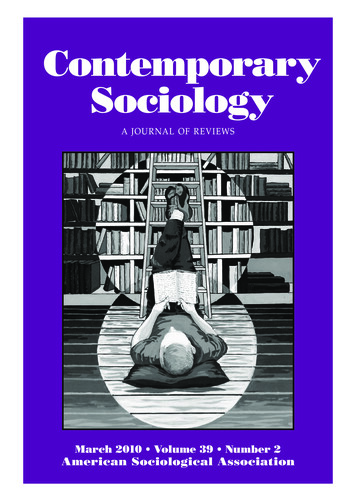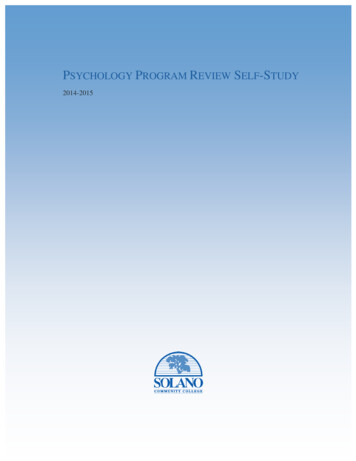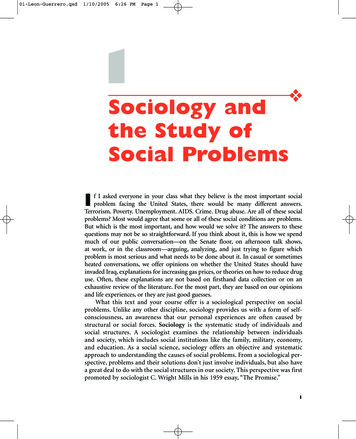
Transcription
01-Leon-Guerrero.qxd1/10/20056:26 PM1Page 1 Sociology andthe Study ofSocial Problemsf I asked everyone in your class what they believe is the most important socialproblem facing the United States, there would be many different answers.Terrorism. Poverty. Unemployment. AIDS. Crime. Drug abuse. Are all of these socialproblems? Most would agree that some or all of these social conditions are problems.But which is the most important, and how would we solve it? The answers to thesequestions may not be so straightforward. If you think about it, this is how we spendmuch of our public conversation—on the Senate floor, on afternoon talk shows,at work, or in the classroom—arguing, analyzing, and just trying to figure whichproblem is most serious and what needs to be done about it. In casual or sometimesheated conversations, we offer opinions on whether the United States should haveinvaded Iraq, explanations for increasing gas prices, or theories on how to reduce druguse. Often, these explanations are not based on firsthand data collection or on anexhaustive review of the literature. For the most part, they are based on our opinionsand life experiences, or they are just good guesses.What this text and your course offer is a sociological perspective on socialproblems. Unlike any other discipline, sociology provides us with a form of selfconsciousness, an awareness that our personal experiences are often caused bystructural or social forces. Sociology is the systematic study of individuals andsocial structures. A sociologist examines the relationship between individualsand society, which includes social institutions like the family, military, economy,and education. As a social science, sociology offers an objective and systematicapproach to understanding the causes of social problems. From a sociological perspective, problems and their solutions don’t just involve individuals, but also havea great deal to do with the social structures in our society. This perspective was firstpromoted by sociologist C. Wright Mills in his 1959 essay, “The Promise.”I1
01-Leon-Guerrero.qxd1/10/20056:26 PMPage 22 SOCIAL PROBLEMSUsing Our Sociological ImaginationAccording to Mills, the sociological imagination can help us distinguish betweenpersonal troubles and public issues. The sociological imagination links our personallives and experiences with our social world. Mills (1959/2000) describes how personaltroubles occur within the “character of the individual and within the range of hisimmediate relationships with others” (p. 8), whereas public issues are a “public matter:some value cherished by publics is felt to be threatened” (p. 8). As a result, the resolution of a trouble can be accomplished by the individual and/or those he or she is incontact with, but the resolution of an issue requires public debate about what valuesare being threatened and the source of such a threat.In his essay, Mills (1959/2000) makes this connection in the case of unemployment.One man unemployed is his own personal trouble. Resolving his unemploymentinvolves reviewing his current situation, reassessing his skills, considering his jobopportunities, and submitting his résumés or job applications to employers. Once hehas a new job, his personal trouble is over. However, what happens when your city orstate experiences high levels of unemployment? What happens when there is a nationwide problem of unemployment? This does not affect just one person, but thousandsor millions. A personal trouble has been transformed into a public issue. This is the casenot just because of how many people it affects; something becomes an issue because ofthe public values it threatens. Unemployment threatens our sense of economic security.It challenges our belief that everyone can work hard to succeed. Unemployment raisesquestions about society’s obligations to help those without a job.We can make the personal trouble-public issue connection with regard to anotherissue, the problem of increasing college tuition. Salvador Henriquez works three jobs,and his wife, Colleen, works two. But even with five jobs between them, they are unableto support their daughter, Ana, a sophomore at New York University. She graduated inthe top 5 percent of her class and receives a 14,300 scholarship, but it does not coverall of her school expenses. Each year, the family takes out an additional 25,000 inloans for Ana’s school expenses (Fresco 2004). Ana and her family may have found away to support her education, but what will Salvador and Colleen Henriquez do whenAna’s three younger siblings are ready for college? Is this a personal trouble facing onlythe Henriquez family? Or is this a public issue?The cost of tuition is rising at a faster rate than family income or student financialaid. During the 1980s, the cost of attending college rose three times as fast as medianfamily income. Between 1981 and 2003, the cost of a public four-year educationincreased by 202 percent, while the consumer price index (the change in the cost ofliving) increased 80 percent (Boehner and McKeon 2003). In the 2003–2004 academic year, the average total fees (tuition, room and board) at a four-year public institution were 10,636, while at four-year private institutions, the average cost was 26,854(College Board 2003).Although most Americans believe that all students have the opportunity to earn acollege degree, a recent study concluded that the promise of a college education is anempty one for low- and moderate-income students. It is estimated that nearly one halfof all college-qualified, low- and moderate-income high school graduates are unable
01-Leon-Guerrero.qxd1/10/20056:26 PMPage 3Sociology and the Study of Social Problems 3to afford college. During the first decade of the twenty-first century, 4.4 million highschool graduates will not attend a four-year college, and about 2 million will attend nocollege at all (Advisory Committee on Student Financial Assistance 2002). On average,poor families spent about 25 percent of their annual income for their children toattend public four-year colleges in 2000. In comparison, middle-income families spent7 percent of their income, and the wealthiest families spent 2 percent of their annualincome (National Center for Public Policy and Higher Education 2002). Collegecost has become a serious social problem, as the “barriers that make higher educationunaffordable serve to erode our economic well being, our civic values, and our democratic ideals” (Callan and Finney 2002:10).The sociological imagination challenges the claim that the problem is “natural” orbased on individual failures, instead reminding us how the problem is rooted insociety (Irwin 2001). We understand that we cannot resolve unemployment by changing one individual at a time. In the same way, we know that the Henriquez family isnot to blame for the high cost of Ana’s education. In both cases, the sociological imagination identifies the structural bases of social problems, making us aware of the economic, political, and social structures that govern employment and unemploymenttrends and the cost of higher education.As Mills (1959/2000) explains, “To be aware of the ideal of social structure and touse it with sensibility is to be capable of tracing such linkages among a great variety ofmilieux. To be able to do that is to possess the sociological imagination” (pp. 10–11).Throughout this text, we will apply our sociological imagination to the study of socialproblems. Before we proceed, we need to understand what a social problem is.What Is a Social Problem?The Negative Consequences of Social ProblemsFirst, a problem is a social condition that has negative consequences forindividuals, our social world, or our physical world. If there were only positive consequences, there would be no problem. A social problem such as unemployment,alcoholism, or drug abuse may negatively impact a person’s life and health, alongwith the well-being of that person’s family and friends. Problems can threaten oursocial institutions, for example, the family (spousal abuse), education (the rising costof college tuition), or the economy (unemployment and underemployment). Ourphysical and social worlds can be threatened by problems related to urbanizationand the environment.Objective and Subjective Realities of Social ProblemsSecond, a social problem has objective and subjective realities. A social conditiondoes not have to be personally experienced by every individual in order to be considered a social problem. The objective reality of a social problem comes fromacknowledging that a particular social condition does exist. For example, you or I donot have to be poor in order to recognize that some men, women, and children experience the consequences of living in poverty. We can confirm the realities of poverty
01-Leon-Guerrero.qxd1/11/20055:15 PMPage 44 SOCIAL PROBLEMSVISUAL ESSAY: SEEING PROBLEMS SOCIOLOGICALLY We often speculate about the causes for the moods andbehaviors we observe in others. If we saw this unhappylittle boy, we might assume that he’s spoiled or tired orsick or perhaps even a temperamental, bratty type.But if we think sociologically and expand our focus beyond this boy to include the social context in whichhe exists, we begin to notice a few things. The social context gives us additional information to explain theindividual and his experiences. One thing we notice is that the boy is part of a family.Another thing we might notice is that his family appears rather poor, at least judging from their clothingand their home and car, seen in the background. We could speculate on the causes of the family’s poverty.We might conclude that their poverty is a result of laziness or a lack of ambition.
01-Leon-Guerrero.qxd1/10/20056:26 PMPage 5Sociology and the Study of Social Problems 5What we have done, however, is to identify personal shortcomings or failures as thesource of problems and to define the family’s poverty as a personal trouble, affectingjust one boy and his family. The sociological imagination provides us with anawareness that personal troubles are often caused by institutional or structuralforces. Take another look at the family, and this time note what is in the background.The boy’s father used to work in the lumber mill but lost his job when the factoryclosed. The sociological imagination reminds us that a social problem is not basedsimply on individual failures but rather is rooted in society. In this case,unemployment is not just experienced by one boy and his family but by all in thecommunity.Which makes more sense to you: Is it better to try to solve the problem of poverty by helpingthis boy and his family, and others like them, one family at a time? Or is it better to seeklong-term solutions through structural changes?
01-Leon-Guerrero.qxd1/10/20056:26 PMPage 66 SOCIAL PROBLEMSby observing conditions in our own community, at local clothing drives, food banks,or shelters. Objective realities of a social problem can be confirmed by the collectionof data. For example, we know from the 2003 U.S. Census figures that 34.6 millionpeople were poor, and among them, the number of children under the age of 18 was12.1 million (Proctor and Dalaker 2003).The subjective reality of a social problem addresses how a problem becomesdefined as a problem. This idea is based on the concept of the social constructionof reality. Coined by Peter Berger and Thomas Luckmann (1966), the term refers tohow our world is a social creation, originating and evolving through our everydaythoughts and actions. Most of the time, we assume and act as though the world is agiven, objectively predetermined outside of our existence. However, according toBerger and Luckmann, we also apply subjective meanings to our existence and experience. In other words, our experiences don’t just happen to us. Good, bad, positive, ornegative—we also attach meanings to our reality.From this perspective, social problems are not objectively predetermined. Theybecome real only when they are subjectively defined or perceived as problematic. Thisperspective is known as social constructionism. Recognizing the subjective aspects ofsocial problems allows us to understand how a social condition may be defined as aproblem by one segment of society but be completely ignored by another. For example,do you believe poverty is a social problem? Some may argue that it is a problem only ifyou are the one who is poor. Or poverty is your problem if you are “lazy” or a “welfaremother.” However, others would argue that it qualifies as society’s problem.Sociologist Denise Loseke (2003) explains that “conditions might exist, peoplemight be hurt by them, but conditions are not social problems until humans categorize them as troublesome and in need of repair” (p. 14). To frame their work, socialconstructionists ask a set of questions:What do people say or do to convince others that a troublesome condition exists that mustbe changed? What are the consequences of the typical ways that social problems attractconcern? How do our subjective understandings of social problems change the objectivecharacteristics of our world? How do these understandings change how we think about ourown lives and the lives of those around us? (Loseke and Best 2003:3–4)The social constructionist perspective focuses on how a problem becomesdefined. In particular, it examines how powerful groups, like politicians, religiousleaders, and the media, can influence our opinions and conceptions of what is a socialproblem. For example, in an effort to preserve their definition of the “traditionalfamily,” conservative political and religious groups encourage laws and practices thatdiscriminate against parents with a gay or lesbian sexual orientation and the familiesthey build. Such groups continue to offer support for the Defense of Marriage Act of1996, which denies federal recognition of same-sex marriages and gives states theright to refuse to recognize same-sex marriages performed in other states. The actalso created a federal definition of marriage: the legal union between one manand one woman as husband and wife. When the act passed, Senator Philip Gramm(R-Texas) explained, “The traditional family has stood for 5,000 years. Are we so wise
01-Leon-Guerrero.qxd1/10/20056:26 PMPage 7Sociology and the Study of Social Problems 7today that we are ready to reject 5,000 years of recorded history? I don’t think so”(CNN 1996). Although conservatives considered the act a victory, opponentsexpressed concern that the act created a social problem, specifically legislating discrimination against gay and lesbian couples and their families. According to SenatorCarol Moseley-Braun (D-Illinois), the act was really about “the politics of fear anddivision and about inciting people in an area which is admittedly controversial”(CNN 1996). From the social constructionist perspective, problems are in the “eye ofthe beholder” (Konradi and Schmidt 2001).Definitions of what is a social problem may even come from grassrootsefforts. The national campaign against drunk driving began in 1980 with a group ofCalifornia mothers. Their organization, Mothers Against Drunk Driving (MADD),has been credited with changing our definition of drunk driving and strengtheningstate and federal drunk-driving laws. The term designated driver, now part of ourlanguage and promoted by bars and restaurants, was originally popularized by MADDin the 1980s (Lord 2000). Currently, MADD boasts more than 600 chapters and3 million members. PUTTING IT TOGETHER:Apply the concepts of “objective” versus “subjective”reality to the social problem of homelessness. Whatare the objective realities of homelessness in yourneighborhood? According to the National LawCenter on Homelessness and Poverty (2002), morethan 3 million women, men, and children werehomeless in 2001. It is estimated that in any givenyear, more than 1.5 million youth between the agesof 12 and 17 spend at least one night in an emergency shelter or on the streets (U.S. Departmentof Housing and Urban Development 1999). Usethe Internet (or local resources) to determine thenumber of homeless in your city or state. What arethe subjective realities of homelessness?The History of Social ProblemsProblems don’t appear overnight; rather, as Malcolm Spector and John Kituse(1987) argue, the identification of a social problem is part of a subjective process.Spector and Kituse identify four stages to the process. Stage 1 is defined as a transformation process: taking a private trouble and transforming it into a public issue. In thisstage, an influential group, activists, or advocates call attention to and define an issueas a social problem. Stage 2 is the legitimization process: formalizing the mannerin which the social problems or complaints generated by the problem are handled.For example, an organization or public policy could be created to respond to thecondition. An existing organization, such as a federal or state agency, could also becharged with taking care of the situation. In either instance, these organizations begin
01-Leon-Guerrero.qxd1/10/20056:26 PMPage 88 SOCIAL PROBLEMSto legitimize the problem by creating and implementing a formal response. Stage 3 isa conflict stage, when Stage 2 routines are unable to address the problem. DuringStage 3, activists, advocates, and victims of the problem experience feelings of distrustand cynicism toward the formal response organizations. Stage 3 activities includereadjusting the formal response system: renegotiating procedures, reforming practices, and engaging in administrative or organizational restructuring. Finally, Stage 4begins when groups believe that they can no longer work within the establishedsystem. Advocates or activists are faced with two options, to radically change theexisting system or to work outside of the system.Understanding the Sociological PerspectiveThe way sociologists conduct sociology and study social problems begins firstwith their view on how the world works. Based on a theory—a set of assumptionsand propositions used for explanation, prediction, and understanding—sociologistsbegin to define the relationship between society and individuals. Theories varyin their level of analysis, focusing on a macro (societal) or a micro (individual)level. Theories help inform the direction of sociological research and data analysis.In the following section, we will review four theoretical perspectives: functionalism, conflict, feminist, and interactionist. Research methods used by sociologists aresummarized below. FOCUS ON: THE SCIENCE OF SOCIOLOGYSociology is not commonsense guessingabout how the world works. In his book,Investigating the Social World (1999:10),Russell Schutt explains how the socialsciences rely “on the use of scientific methods to investigate individuals, societies, andsocial process [and on] the knowledge produced by these investigations.”Research is divided into two areas:basic and applied. The knowledge we gainthrough basic research expands our understanding of the causes and consequences of asocial problem, for example, homelessnessamong female-headed households or declining educational attainment among Latinastudents. On the other hand, appliedresearch involves the pursuit of knowledgefor program application or policy evaluation (Katzer, Cook, and Crouch 1998). Often,social programs are evaluated for their effectiveness in reducing a problem or in creating some desired change. The informationgained through applied research can beincorporated into social programs servinghomeless female-headed households orLatina high school students.All research begins with a theory—identifying the phenomenon we’re tryingto explain and then offering an explanationfor social patterns or causal relationships
01-Leon-Guerrero.qxd1/10/20056:26 PMPage 9Sociology and the Study of Social Problems 9 FOCUS ON (Continued)between variables (Frankfort-Nachmiasand Leon-Guerrero 2003). Variables area property of people or objects that cantake on two or more values. As we try toexplain homelessness, we may have aspecific explanation about the relationshipbetween two variables, for example, educational attainment and homelessness amongfemale-headed households. Educationcould be measured according to differentcategories: less than a high school degree, ahigh school degree, some college, or abachelor’s degree or higher. Homelessnesscould be measured according to whethera woman and her family experiencedhomelessness in the previous 10 years. Therelationship between these variables can bestated in a hypothesis, a tentative statement about how the variables are related toeach other. We could predict that highereducational attainment will decrease thelikelihood that a woman and her familywill experience homelessness. In thishypothesis statement, we’ve identified adependent variable (the variable to beexplained, homelessness among femaleheaded households) along with an independent variable (the variable expected toaccount for the cause of the dependentvariable, educational attainment). Data mayconfirm or refute this hypothesis.Research methods can include quantitative or qualitative approaches or a combination. Quantitative methods rely on thecollection of statistical data. It requires thespecification of variables and scales collected through surveys, interviews, or questionnaires. Qualitative methods are designed tocapture social life as participants experienceit. These methods involve field observation,depth interviews, or focus groups.A brief description of research methods based on Schutt’s text is presented inthe following table.Research MethodDescriptionSurvey researchCollection of data based on responses to a series of questions. Surveys canbe offered in several formats: a self-administered mailed survey, groupsurveys, in-person interviews, or telephone surveys.Field observationThis category includes data collection conducted in the field, emphasizingthe observations about natural behavior as experienced or witnessed bythe researcher. Field observation can include participant observation,focus groups, and/or intensive interviewing techniques.Historical andcomparative methodsResearch that focuses on one historical period or traces a sequence ofevents over a number of years. Comparative research involves multiplecases or data from more than one time period.Secondary data analysisResearch that involves working with data that the researcher did notoriginally design or collect. Secondary data analysis usually involvesthe analysis of large public data sets, such as the U.S. Census, theGeneral Social Survey, or the National Election Survey.
01-Leon-Guerrero.qxd1/10/20056:26 PMPage 1010 SOCIAL PROBLEMSThe Functionalist PerspectiveAmong the theorists most associated with the functionalist perspective is Frenchsociologist Emile Durkheim. Borrowing from biology, Durkheim likened society toa human body. As the body has essential organs, each with a specific function inthe body, he theorized that society has its own organs: the institutions of the family,economy, politics, education, and religion. These organs: or social structures haveessential and unique functions. For example, the institution of the family maintainsthe health and socialization of our young and creates a basic economic unit. The institution of education provides knowledge and skills for women and men to work andlive in society. No other institution can do what the family or education does.Durkheim proposed that the function of society was to civilize or controlindividual actions. He wrote, “It is civilization that has made man what he is; it iswhat distinguishes him from the animal: man is man only because he is civilized”(Durkheim 1914/1973:149). The social order can be threatened during periods ofrapid social change, such as industrialization or political upheaval, when social normsand values are likely to be in transition. During this state of normlessness or anomie,Durkheim believed society was particularly prone to social problems. As a result, socialproblems cannot be solved by changing the individual; rather the problem has to besolved at the societal level. The entire social structure or the affected part of the socialstructure needs to be repaired.The functionalist perspective, as its name suggests, examines the functions orconsequences of the structure of society. Functionalists use a macro perspective, focusing on how society creates and maintains social order. Social problems are notanalyzed in terms of how “bad” it is for parts of society. Rather, a functionalist asks:How does the social problem emerge from the society? Does the social problem servea function?The systematic study of social problems began with the sociologists at theUniversity of Chicago. Part of what has been called the Chicago School of Sociology,scholars such as Ernest W. Burgess, Homer Hoyt, Robert Park, Edward Ullman, andLouis Wirth used their city as an urban laboratory, pursuing field studies of poverty,crime, and drug abuse during the 1920s and 1930s. Through their research, theycaptured the real experiences of individuals experiencing social problems, notingthe positive and negative consequences of urbanization and industrialization (Ritzer2000). Taking it one step further, sociologists Jane Addams and Charlotte Gilman notonly studied urban life in Chicago but also developed programs to assist the poor andlobbied for legislative and political reform (Adams and Sydie 2001).According to Robert Merton (1957), social structures can have positive benefitsas well as negative consequences, which he called dysfunctions. A social problem suchas homelessness has a clear set of dysfunctions but can also have positive consequences or functions. One could argue that homelessness is clearly dysfunctionaland unpleasant for the women, men, and children who experience it; and for a cityor community, homelessness can serve as a public embarrassment. Yet, a functionalist would say that homelessness is beneficial for at least one part of society, or elseit would cease to exist. Think of it, the population of the homeless supports an
01-Leon-Guerrero.qxd1/10/20056:26 PMPage 11Sociology and the Study of Social Problems 11industry of social service agencies, religious organizations, and community groupsand service workers. In addition, the homeless also serve to highlight problems inother parts of our social structure, namely the problems of the lack of a livable wageor affordable housing. PUTTING IT TOGETHER:Merton (1957) separated functions into two categories: manifest and latent. Manifest functions arethe consequences that are intended and recognized,whereas latent functions are the consequences thatare unintended and often hidden. What are themanifest and latent functions of homelessness?The Conflict PerspectiveLike functionalism, conflict theories examine the macro level of our society, itsstructures and institutions. Whereas functionalists argue that society is held togetherby norms, values, and a common morality, conflict theorists consider how society isheld together by power and coercion (Ritzer 2000) for the benefit of those in power.In this view, social problems emerge from the continuing conflict between groups inour society—based on social class, gender, ethnicity/race—and in the conflict, thepowerful groups usually win. As a result, this perspective offers no easy solutions tosocial problems. There could be a total overhaul of the system, but that is unlikely tohappen. We could reform parts of the structure, but those in power would retain theircontrol. The biggest social problem from this perspective is the system itself and theinequality it creates.The first to make this argument was German philosopher and activist Karl Marx.Conflict, according to Marx, emerged from the economic substructure of capitalism,which defined all other social structures and social relations. He focused on the conflictbased on social class, created by the tension between the proletariat (workers) and thebourgeoisie (owners). Capitalism did more than separate the haves and have-nots.Unlike Durkheim, who believed that society created a civilized man, Marx argued that acapitalist society created a man alienated from his species being, from his true self.Alienation occurred on multiple levels: Man would become increasingly alienatedfrom his work, the product of his work, other workers and finally, his own human potential. For example, a salesperson could be so involved in the process of her work that shedoesn’t spend quality time with her coworkers, talk with her customers, or stop andappreciate the merchandise. Each sale transaction is the same; all customers and workers are treated alike. According to Marx, workers needed to achieve a class consciousness,an awareness of their social position and oppression, in order to unite and overthrowcapitalism, replacing it with a more egalitarian socialist/communist structure.Widening Marx’s emphasis on the capitalist class structure, contemporary conflicttheorists have argued that conflict emerges from other social bases, such as values,resources, and interests. C. Wright Mills (1959/2000) argued the existence of a “powerelite,” a small group of political, business, and military leaders who control our society.
01-Leon-Guerrero.qxd1/10/20056:26 PMPage 1212 SOCIAL PROBLEMSRalf Dahrendorf (1959) explained that conflict of interest is inherent in any relationshipbecause those in powerful positions will always seek to maintain their dominance. LewisCoser (1956), in The Functions of Social Conflict, focused on the functional aspects ofconflict, arguing that conflict creates and maintains group solidarity by clarifying thepositions and boundaries between groups. Conflict theorists may also take a socialconstructionist approach, examining how social problems are subjectively define
structural or social forces.Sociology is the systematic study of individuals and social structures. A sociologist examines the relationship between individuals and society, which includes social institutions like the family, military, economy, and education. As a social science,



